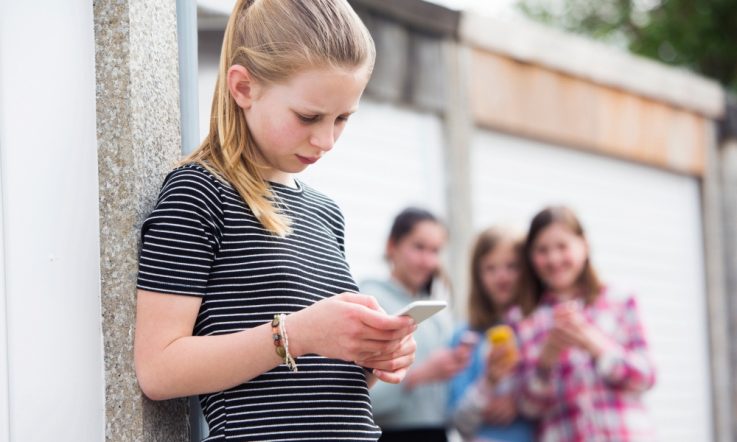Sexual harassment, including online sexual abuse, has become ‘normalised’ for children and young people and so commonplace for some that they see no point in reporting it to teachers and school staff, according to the findings of a review in England.
One of the recommendations to come out of the Ofsted rapid review is that school and college leaders act on the assumption that sexual harassment is affecting their pupils and take a whole-school approach to addressing the issue.
The inspection team visited 32 schools and colleges and spoke to more than 900 children and young people. They then surveyed just over 800 of those students, aged 13 and above, about the ‘prevalence of peer-on-peer sexual harassment and sexual violence, including online, in their lives and the lives of their peers’. They also spoke to school leaders, teachers, governors, partner agencies such as the police, parents and stakeholders.
‘It is a concern that this review has identified that many instances of sexual harassment, including the pressure to share nudes and the sharing of youth-produced sexual imagery without consent, are going unrecognised or unchallenged by school staff,’ the review report says. ‘We are especially concerned that for some children and young people this is so commonplace that they see no point in raising it as a concern with staff.’
In one school, students told inspectors ‘boys talk about whose “nudes” they have and share them among themselves – it’s like a collection game’. And, girls at one school reported they could be contacted by ‘up to 10 or 11 different boys a night to be asked for nude/semi-nude images’. Some girls had experienced unwanted touching in school corridors, and some said they felt uncomfortable when boys walked behind them up stairs and in stairwells, where they could see up their skirts.
Inspectors found some evidence suggesting access to technology and sharing of inappropriate images and videos is also an issue in primary schools. There was an example in one K-12 school of Year 6 and 7 students sending nudes.
The review report says, in focus groups: ‘… many students talked about teachers not “knowing the reality” of their lives, or being “out of date”. In general, they reported much higher incidences of sexual harassment, online sexual abuse and bullying behaviours than teachers and leaders tended to be aware of.’
However, in some schools teacher and leader perceptions were well aligned with those of their students. Inspectors said this appeared to be the case ‘in schools where the topic has been – and continues to be – openly discussed and challenged, and where records of incidents are kept and analysed’. Routine record-keeping and analysis to identify patterns is one of the report’s recommendations.
The UK Government asked Ofsted to undertake the rapid review of sexual harassment in schools and colleges in April, after anonymous testimonials of sexual abuse were published on the website ‘Everyone’s Invited’.
Most common forms of behaviour
In the survey, students were asked about harmful sexual behaviours between people their age. Ofsted says the following findings are strongly supported by existing research.
For girls, the three most common face-to-face forms of behaviour that happened ‘a lot’ or ‘sometimes’ were sexist name-calling (92 per cent), rumours about their sexual activity (81 per cent) and unwanted or inappropriate comments of a sexual nature (80 per cent).
For online or social media, it was being sent pictures or videos they did not want to see (88 per cent), being put under pressure to provide sexual images of themselves (80 per cent) and having pictures or videos that they sent being shared more widely without their knowledge or consent (73 per cent). WhatsApp and Snapchat were typical platforms for sharing images and videos.
For contact forms of harmful sexual behaviours happening to them or their peers, 79 per cent of girls said sexual assault of any kind happened ‘a lot’ or ‘sometimes’, followed by feeling pressured to do sexual things that they did not want to (68 per cent), and unwanted touching (64 per cent).
The review found boys were much less likely to think these behaviours happened, to them or their peers. For example, 50 per cent said being sent explicit pictures or videos of things they did not want to see happens ‘a lot’ or ‘sometimes’. The percentages were lower for contact forms of sexual behaviour – sexual assault of any kind (38 per cent); feeling pressured to do sexual things they did not want to (27 per cent); unwanted touching (24 per cent).
The review notes the lack of centralised data collection of incidents in the UK makes it hard to get an accurate picture of the scale and nature of sexual harassment and violence between students in schools and colleges.
‘Overall, children and young people tended to say that they felt physically safe at college or school, although there was a clear emotional impact on girls who experienced regular sexual harassment or other harmful sexual behaviour,’ the report says.
When asked where sexual violence typically occurs, the students talked about spaces outside school unsupervised by adults, such as parties and parks.
Speaking to adults and reporting incidents
The children and young people involved in the review said they rarely spoke to adults about what was happening, even though they told inspectors sexual harassment and online sexual abuse are common in their daily lives.
From most to least likely, they said they would tell: a friend; a parent or carer; another family member; an adult at their school or college; the police; a helpline/charity; someone else, including a social worker, coach or religious leader. When they said they would talk to an adult at school about sexual harassment and sexual violence (including online) they tended to identify a member of the senior staff.
Reasons for not always wanting to talk to adults – even when there is good practice in their school and they are encouraged to talk – included concerns about ‘reputational damage’ or being socially ostracised by their peers. They were also worried about getting peers into trouble and what might happen next if they reported an incident, including the potential for police to become involved.
Other worries were not being believed or being blamed. Students told the review team they thought they would be listened to if it was a ‘serious’ incident but they would be less likely to report incidents that thought were ‘common’ – such as being asked for nudes and boys making comments to them in school corridors.
Some talked about reporting previous incidents, only for it to ‘come to nothing’. ‘Consequently, they did not believe that the school would do anything if they did report abuse, especially if incidents took place outside school,’ the review report says.
It says school staff cannot rely on students coming to them, and having clear procedures and visible staff and supports are not always enough on their own.
Explicit teaching and support for schools
One girl told the review team ‘it shouldn’t be our responsibility to educate boys’. Some were frustrated there was no explicit teaching of what constituted acceptable and unacceptable behaviour. Most students said the relationships, sex and health education (RSHE) they’d experienced was too little too late and the curriculum didn’t give the information and advice they needed to navigate the reality of their daily lives. They said they often turned to social media or their peers to educate each other and fill in the gaps.
The review says current guidance is insufficient for school leaders and that schools and colleges cannot and should not tackle sexual harassment and sexual violence, including online, on their own. ‘For example, the prevalence of children and young people seeing explicit material they do not want to see and being pressured to send “nudes” is a much wider problem than schools can address. While they can play their part, it is not only their responsibility to solve it.’
The review team makes several recommendations for school and college leaders, multiagency partners, and the government. These include high quality training for teachers delivering RHSE, and training for all school staff to better understand, identify and respond to issues.
Ofsted Chief Inspector Amanda Spielman says the review findings shocked her. ‘It’s alarming that many children and young people, particularly girls, feel they have to accept sexual harassment as part of growing up. Whether it’s happening at school or in their social life, they simply don’t feel it’s worth reporting.
‘This is a cultural issue; it’s about attitudes and behaviours becoming normalised, and schools and colleges can’t solve that by themselves. The government needs to look at online bullying and abuse, and the ease with which children can access pornography. But schools and colleges have a key role to play. They can maintain the right culture in their corridors and they can provide RSHE that reflects reality and equips young people with the information they need.’
If you need help, or if you would like to talk to a trained professional about the issues raised in this article, contact Kids Helpline on 1800 55 1800 or Lifeline on 13 11 14. If you believe a child is in immediate danger call the Police on 000.
References
Ofsted. (2021, June 10). Research and analysis. Review of sexual abuse in schools and colleges. GOV.UK. https://www.gov.uk/government/publications/review-of-sexual-abuse-in-schools-and-colleges
To read the full report and recommendations, click on the link.



